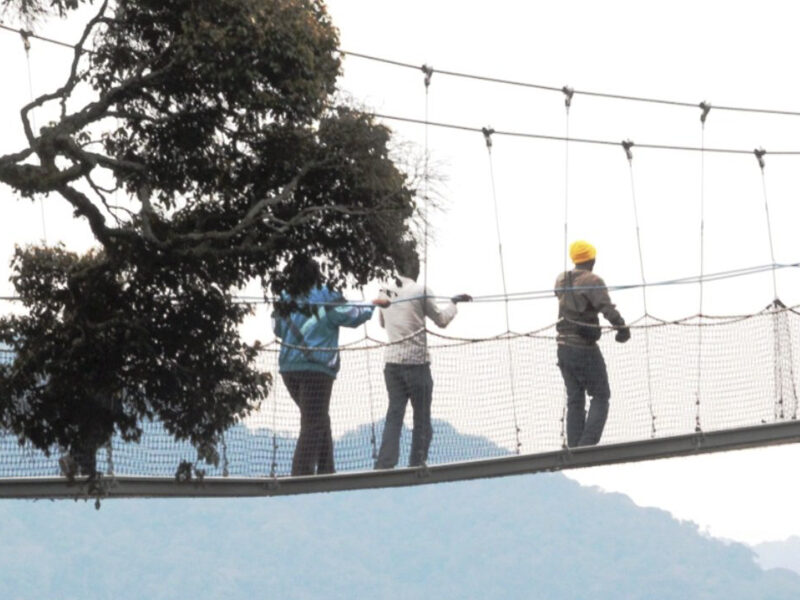Arrive at Kilimanjaro Airport where you will be met by our representative, and transferred to Mt. Village Lodge. The Mountain Village Lodge is situated on a coffee plantation with views of Mt. Meru and Kilimanjaro. Your accommodation will be in one of the charming stone cottages sit amidst beautiful gardens overlooking Lake Duluti.
Arrive at Kilimanjaro Airport where you will be met by our representative, and transferred to Mt. Village Lodge. The Mountain Village Lodge is situated on a coffee plantation with views of Mt. Meru and Kilimanjaro. Your accommodation will be in one of the charming stone cottages sit amidst beautiful gardens overlooking Lake Duluti.
Day 2: TARANGIRE NATIONAL PARK
After breakfast, you will depart by road to your private tented camp, situated at the boundary of Tarangire National Park. Tarangire, Tanzania’s third largest national park is known for it’s majestic baobab trees that dot the landscape, dwarfing the animals that feed beneath them. The park supports a great diversity of wildlife, especially during in the dry season of July to November, when the Tarangire River provides the only permanent water supply in the area. During this season wildlife , including up to 6.000 elephants concentrate along the river.
For a cultural experience, walking in the area and visits to some neighboring tribes is offered. Maasai live in the area as well as the Datoga, another tribe of semi-nomadic pastoralists who migrated into this area many decades ago, looking for good grazing land. The Dataoga have resisted neighbouring tribes’ cultural infiltrations. The women, still wear fat treated goatskin gowns and carve their faces and bodies to beautify themselves . Learning about their history is as fascinating as the views are breathtaking from the several hilltop peaks in the area.
Day 3: TARANGIRE NATIONAL PARK
After breakfast, you will depart by road to your private tented camp, situated at the boundary of Tarangire National Park. Tarangire, Tanzania’s third largest national park is known for it’s majestic baobab trees that dot the landscape, dwarfing the animals that feed beneath them. The park supports a great diversity of wildlife, especially during in the dry season of July to November, when the Tarangire River provides the only permanent water supply in the area. During this season wildlife , including up to 6.000 elephants concentrate along the river.
For a cultural experience, walking in the area and visits to some neighboring tribes is offered. Maasai live in the area as well as the Datoga, another tribe of semi-nomadic pastoralists who migrated into this area many decades ago, looking for good grazing land. The Dataoga have resisted neighbouring tribes’ cultural infiltrations. The women, still wear fat treated goatskin gowns and carve their faces and bodies to beautify themselves . Learning about their history is as fascinating as the views are breathtaking from the several hilltop peaks in the area.
Day 4: TARANGIRE - LAKE MANYARA- GIBB'S FARM
After breakfast you’ll drive across the floor of the Great Rift Valley to Lake Manyara National Park. This beautiful park with it’s lush vegetation and tropical forests of giant fig and mahogany trees, takes its name from the Maasai word for ”euphorbia tirucalli”, a bush which is used to make a thorny hedge to protect their cattle. Elephant, giraffe, buffalo, zebra and a variety of antelope inhabit the park as well as a variety of monkeys and a large population of hippo’s. . If you are lucky you may see the Manyara lions, well known for their tree climbing habits, lazily resting on the branches of an ”Acacia tortilis” tree. The birdlife is also abundant, with flamingoes, pelicans, hornbills and plenty of forest species.
After a game drive and a picnic lunch in the park you’ll depart for the Ngorongoro highlands and your overnight accommodation at Gibb’s Farm. This delightful farm is situated on the outer slopes of Ngorongoro Crater and is renowned for their friendly service and excellent cuisine. In the evening a hike is possible to the coffee plantation or to the water fall.
Day 5: NGORONGORO CRATER
This morning your drive takes you the short distance to the ”eighth wonder of the world”, the Ngorongoro Crater, the largest unbroken caldera on earth. The floor of this collapsed volcano spreads for 102 sq. miles and the walls are 2000ft high, a truly awesome sight. The crater floor is a virtual ”Noah’s Ark”, inhabited by almost every species of wildlife indigenous to East Africa including the black named lion and the endangered black rhino. The crater contains a river, several swamps, a soda lake – complete with flamingoes, a forest and open plains. With a picnic lunch you will descend the crater walls and spend the afternoon and early evening wildlife viewing on the crater floor. , returning to your lodge in time for a sundowner on the verandah.
Your lodging for the next two nights will be at the Ngorongoro Serena Lodge. Perched on the edge of the crater, this beautiful lodge affords panoramic views of the crater floor.
Day 6: NGORONGORO CRATER
After an early breakfast you will depart for a half day of wildlife viewing on the crater floor (where from July 2006 only half day game drives are possible)
On this day you can visit Empakaai and Olmoti Craters instead of Ngorongoro Crater game drive, less famous and less visited, but very interesting for Walking Safaris off the beaten track.
Day 7: SERENGETI NATIONAL PARK
After breakfast depart for Serengeti National Park with a stop enroute at Oldupai Gorge. Oldupai is the famous archeological site where the Leakeys discovered remains of Australopithecus, Homo Habilis and Homo Erectus, bringing crucial understanding to the study of the evolution of the human species.
From Oldupai you’re off to the “Great Serengeti”, likely the most famous wildlife sanctuary in the world. The vast Serengeti plains cover an area of over 14,763 square kilometers and during the months of the migration, is the habitat of huge numbers of wildebeest, zebra and Thomson’s gazelle with estimates of up to 1.5 million. From December through March they concentrate at the Ndutu and Salei plains, where the calving season takes place, attracting the attention of predators like lion, cheetah and hyena. In June and July they move into the western corridor and in October and November the herds can usually be found in the northern Serengeti. The Serengeti ”Kopjes”, massive boulder islands of granite standing in a sea of grass, provide shelter to a great variety of plants and animals, from the elusive leopard to the tiny dik dik.
You will spend four nights in a luxury private camp, set in a wilderness area, depending on the season and movement of the animals.
Day 8: SERENGETI NATIONAL PARK
After breakfast depart for Serengeti National Park with a stop enroute at Oldupai Gorge. Oldupai is the famous archeological site where the Leakeys discovered remains of Australopithecus, Homo Habilis and Homo Erectus, bringing crucial understanding to the study of the evolution of the human species.
From Oldupai you’re off to the “Great Serengeti”, likely the most famous wildlife sanctuary in the world. The vast Serengeti plains cover an area of over 14,763 square kilometers and during the months of the migration, is the habitat of huge numbers of wildebeest, zebra and Thomson’s gazelle with estimates of up to 1.5 million. From December through March they concentrate at the Ndutu and Salei plains, where the calving season takes place, attracting the attention of predators like lion, cheetah and hyena. In June and July they move into the western corridor and in October and November the herds can usually be found in the northern Serengeti. The Serengeti ”Kopjes”, massive boulder islands of granite standing in a sea of grass, provide shelter to a great variety of plants and animals, from the elusive leopard to the tiny dik dik.
You will spend four nights in a luxury private camp, set in a wilderness area, depending on the season and movement of the animals.
Day 9: SERENGETI NATIONAL PARK
After breakfast depart for Serengeti National Park with a stop enroute at Oldupai Gorge. Oldupai is the famous archeological site where the Leakeys discovered remains of Australopithecus, Homo Habilis and Homo Erectus, bringing crucial understanding to the study of the evolution of the human species.
From Oldupai you’re off to the “Great Serengeti”, likely the most famous wildlife sanctuary in the world. The vast Serengeti plains cover an area of over 14,763 square kilometers and during the months of the migration, is the habitat of huge numbers of wildebeest, zebra and Thomson’s gazelle with estimates of up to 1.5 million. From December through March they concentrate at the Ndutu and Salei plains, where the calving season takes place, attracting the attention of predators like lion, cheetah and hyena. In June and July they move into the western corridor and in October and November the herds can usually be found in the northern Serengeti. The Serengeti ”Kopjes”, massive boulder islands of granite standing in a sea of grass, provide shelter to a great variety of plants and animals, from the elusive leopard to the tiny dik dik.
You will spend four nights in a luxury private camp, set in a wilderness area, depending on the season and movement of the animals.
Day 10: SERENGETI NATIONAL PARK
After breakfast depart for Serengeti National Park with a stop enroute at Oldupai Gorge. Oldupai is the famous archeological site where the Leakeys discovered remains of Australopithecus, Homo Habilis and Homo Erectus, bringing crucial understanding to the study of the evolution of the human species.
From Oldupai you’re off to the “Great Serengeti”, likely the most famous wildlife sanctuary in the world. The vast Serengeti plains cover an area of over 14,763 square kilometers and during the months of the migration, is the habitat of huge numbers of wildebeest, zebra and Thomson’s gazelle with estimates of up to 1.5 million. From December through March they concentrate at the Ndutu and Salei plains, where the calving season takes place, attracting the attention of predators like lion, cheetah and hyena. In June and July they move into the western corridor and in October and November the herds can usually be found in the northern Serengeti. The Serengeti ”Kopjes”, massive boulder islands of granite standing in a sea of grass, provide shelter to a great variety of plants and animals, from the elusive leopard to the tiny dik dik.
You will spend four nights in a luxury private camp, set in a wilderness area, depending on the season and movement of the animals.
Day 11: SERENGETI - ARUSHA
Today you’ll enjoy a final gamedrive across the Serengeti plains enroute to the Seronera Airstrip where you will board the scheduled flight to Zanzibar.
Day 12: BEACH HOTEL ZANZIBAR
Relax and enjoy Zanzibars Beaches. Besides relaxing there are lots of watersports activities you can do there, like sailing, diving and snorkelling.
Day 13: BEACH HOTEL ZANZIBAR
Relax and enjoy Zanzibars Beaches. Besides relaxing there are lots of watersports activities you can do there, like sailing, diving and snorkelling.
Day 14: BEACH HOTEL ZANZIBAR
Relax and enjoy Zanzibars Beaches. Besides relaxing there are lots of watersports activities you can do there, like sailing, diving and snorkelling.
Day 15: ZANZIBAR - STONETOWN
Today we will transfer you to your hotel in Stonetown. On the way we will do the Spice Tour. We have developed a special Spice Tour with in depth information not only about spices, but also organically grown herbs and a detailed description about their traditional uses in medicine cosmetics and cooking. After the tour we invite for an opulent lunch at our guides’ home, where you can taste the spices and fruits.
In the afternoon we will do the City Tour to show you Zanzibars bustling markets, ancient buildings and monuments. A guided tour through Stonetown is one of the highlights Zanzibar has to offer.
Day 16: ZANZIBAR – AIRPORT
Departure to airport Zanzibar





